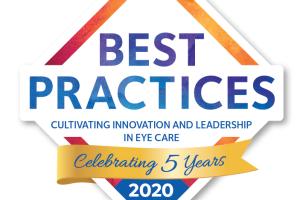Over time, the role of optometrists has evolved to include services far beyond refraction, as they are trained and licensed to diagnose and treat a wide range of eye diseases. Practices that adopt the so-called “medical model” view it as an opportunity to provide a better quality of care while growing practice revenue, and ultimately, increasing patient retention.
2020 Best Practices Honorees Robert Allen, OD, of Associates in Eyecare in Virginia and D.C., and Arthur Epstein, OD, of Phoenix Eye Care and the Dry Eye Center of Arizona have each discovered a passion for disease management, which has been the foundation for the way they practice.
How did you build the disease management portion of your practice?
Epstein: Disease management was built into our practice from the beginning based on our education, training, and interests. I spent most of my career working in medical eye care in a variety of settings, and my wife and partner, Dr. Shannon Steinhauser, who shares my passion also completed a residency in ocular disease. When we opened our practice here in Arizona, it seemed natural to focus on medical optometry because of our comfort handling challenging cases. In addition, emergency after-hours eye care was unavailable in our area, so we saw an opportunity to fill that void–to be that resource for patients who need that care.
Allen: Over the years, the evolution of state legislation has set the stage for medical optometry, as new laws have expanded our scope of practice to recognize our advanced clinical training. We built our practice based on what we are permitted to do, and the additional training we’ve received. Further, we reasonably know what is on the horizon and prepare our practice for upcoming advances in our ability to help our patients. From our perspective, if we have the opportunity to offer a medical solution (procedure or treatment) to our patents, we’re going to build the infrastructure to accomplish it and train our associates accordingly.
Have you chosen to subspecialize in a particular therapeutic area? What do you find most rewarding about it?
Allen: Our practice is unique in that we’re able to cover all aspects of optometric care due to the fact that we have 30 doctors with diverse clinical interests and medical specialties. Personally, my interests concentrate in the areas of dry eye, glaucoma and pursuing improved visual outcomes utilizing specialty custom contact lenses. Dry eye disease is a particularly busy area of practice because so many people suffer from it. Dry eye disease often has a significantly negative impact on a patient’s quality of life, so I find it highly rewarding to assist patients in solving that problem to improve their happiness, wellbeing, and visual acuity.
Epstein: I enjoy all aspects of optometry practice, but over the course of my career, I realized my passion was in dry eye and ocular surface disease. And we just so happened to open a practice in one of the driest, most challenging climates in the country. We took an “if we build it, they will come” approach to opening the Dry Eye Center of Arizona alongside our primary care practice, and I decided to focus there—a little more than a year after we opened I made the difficult choice to not to see primary care patients anymore. I miss it sometimes, but when you immerse yourself in something like this, every day is an opportunity to learn. I’ve been able to spend a lot of time unraveling the mysteries of how the eye and the ocular surface work; the complexity and beauty is amazing. For me, it’s about changing people’s lives. Patients often cry in our office because it’s the first time they’ve felt head, or we’ve been able to achieve significant improvement for them. That’s the most rewarding.
How important are co-management relationships in a successful medical model? How do you build them?
Allen: Our co-management relationships are very important. We work closely with the best sub-specialists and surgeons so that we can be confident that our patients are getting the highest level of care. In addition, we are assured that they’ll send out patients back to us for further care. We can make certain that they understand the breadth of our clinical abilities and capabilities in the office setting. Our relationships with our surgeons are highly symbiotic, as we refer patients to each other, and we are in communication on almost a daily basis. When you have that type of relationship, one based on mutual respect for each other’s proven clinical abilities, it benefits the patient, we as practitioners and the practice. By the time a patient comes back to me following a surgery, I’ve been fully briefed on everything and I’m ready to resume their care in our practice.
Epstein: With the exception of surgery, we’re able to manage almost all medical patients in our office. At the end of the day, we just want to make sure they get the care they need. We have very traditional referral relationships, where other optometrists refer to us when necessary. We work with them and then make sure to always send them back to where they came from. We refer patients for specialty optometric care – low vision and vision therapy or when a colleague is closer to where the patient is.
What have been the advantages of adopting the medical model to your business?
Epstein: The COVID-19 pandemic has served as a pressure test for us. By providing the level of care that we do, we are providing services that are essential in the truest sense of the word. We have been able to keep people out of emergency rooms at a time when that was the worst place to be. People are always going to have eye infections and conditions that need to be managed. From a competitive standpoint, the medical model puts practices in a position to differentiate themselves from others, and for us, it balances our business. We still focus on primary care optometry, of course, but we’re not dependent on that alone. Disease management has solidified our practice and made it much more stable against competition and challenges like this pandemic.
Allen: The medical model approach has positively impacted our ability to help our patients, our profile in the community and practice profitability. The COVID-19 pandemic has become a proof of concept. As we curtailed routine care, we remained relatively busy responding to the need for medical eyecare. We are classified as essential medical, and the concentration on a medical model ensured that we were able to remain open and help those that needed our care. The pace is also more comfortable, allowing us to spend much more time with patients. Our patients recognize our ability to respond to the breadth of their eyecare needs. They trust us and refer their family and friends. Thus, we are perceived as a medical eyecare practice and not an optical retailer.
4 Steps to Adopting the Medical Model
Define the possibilities.
What are you and your associates trained and certified to do? Start with an inventory of the services you can offer. Begin with something you’re passionate about and feel comfortable doing.
Assess the landscape.
Make sure there is a need in your area for the services you are planning to offer. If you are surrounded by ophthalmologists, it’s going to be more difficult to get a solid foothold and your success may be delayed or curtailed. Look for the gaps in care that you can fill.
Invest in the technology.
You can’t manage glaucoma without a digital field machine and OCT at the absolute minimum. To successfully manage dry eye, there is a wide range of diagnostic testing required and often specialized equipment is necessary to obtain the best treatment outcomes. In brief, disease management requires not only advanced clinical testing, but specialized technology as well.
Figure out billing and insurance reimbursements.
Optometrists often feel guilt about charging patients for services. While many medical services are covered by insurance, there is testing and procedures that aren’t. A critical aspect of preparation is determining how to set your fee schedule appropriately and ensure you will be reimbursed appropriately for your care.
For more information about CooperVision’s Best Practices, its honorees (current and past), and updates on how they are working to support and advance the profession, visit www.eyecarebestpractices.com.








